Recent Storm Damage Posts
Winter Home Maintenance Tips for West Valley City Residents
1/17/2025 (Permalink)
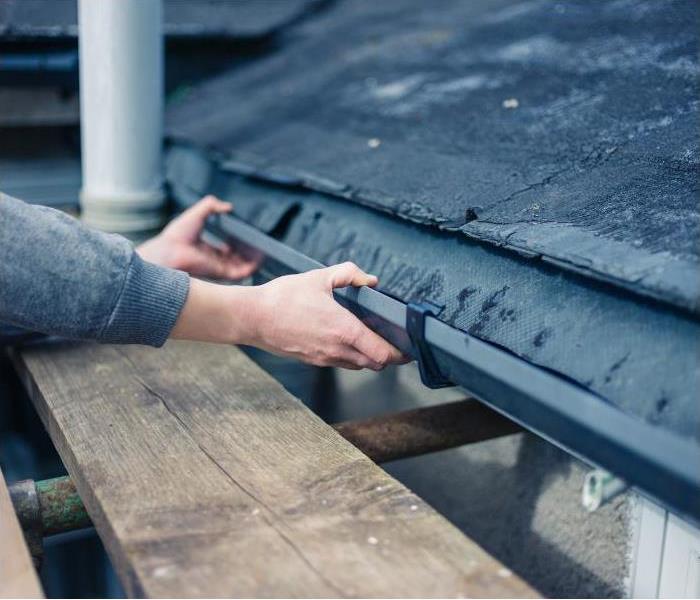 Winter Home Maintenance in West Valley City, UT.
Winter Home Maintenance in West Valley City, UT.
As we settle into the heart of the winter season in West Valley City, Utah, the cold temperatures, snow, and occasional rain create unique challenges for homeowners. The chilly weather brings not only cozy moments indoors but also potential risks to your home, including water damage, frozen pipes, and fire hazards. Fortunately, taking a few simple preventative steps can help ensure that your home stays safe, dry, and efficient during these colder months.
At SERVPRO® of West Valley City, we're here to help you maintain your home’s well-being throughout winter. Whether it's preventing frozen pipes or ensuring your heating system is functioning properly, these tips will keep your home safe and minimize the risk of damage.
1. Protect Your Pipes from Freezing
Winter temperatures in West Valley City can drop below freezing, creating the risk of water pipes freezing and bursting. This common issue can lead to extensive water damage that requires costly repairs and can disrupt your household.
To protect your pipes, consider the following tips:
- Insulate Exposed Pipes: Make sure that any exposed pipes, especially in basements, attics, or garages, are insulated. Pipe insulation sleeves or heating tape are inexpensive options that can prevent freezing.
- Keep Cabinets Open: If you have pipes under sinks, particularly those on exterior walls, leave the cabinet doors open to allow warm air to circulate around the pipes.
- Allow Faucets to Drip: During extremely cold temperatures, letting a faucet drip slightly can prevent pressure from building up and causing pipes to burst.
- Shut Off Outdoor Faucets: Disconnect and drain any hoses, and shut off water to exterior faucets. A freeze in these pipes can affect your water system inside the home.
2. Regularly Inspect Your Roof and Gutters
Winter weather can bring heavy snow and ice, leading to potential roof damage and gutter blockages. Keeping your roof in good condition is crucial for preventing water damage due to ice dams and melting snow.
Here’s how to prevent issues:
- Clear Gutters and Downspouts: Make sure gutters are free from leaves and debris, allowing snowmelt to flow off the roof. Clogged gutters can lead to water pooling on the roof, creating the risk of leaks.
- Inspect Roof Shingles: Look for missing or damaged shingles that might allow water to seep into your home. Snow accumulation can worsen existing damage, so it’s important to address it early.
- Remove Snow Buildup: If snow accumulates on your roof, carefully remove it with a roof rake. Avoid using metal tools, which can damage shingles. Ice dams can form when water is trapped by snow, leading to leaks inside your home.
3. Maintain Your Heating System
Your heating system works overtime during the winter, and it’s essential to ensure it’s operating safely and efficiently. A well-maintained system not only keeps your home comfortable but also prevents fire hazards.
Follow these tips:
- Replace Filters: Dirty filters can restrict airflow and reduce the efficiency of your heating system. Replace them regularly for optimal performance.
- Schedule a Professional Inspection: Have a professional technician inspect and service your furnace before the cold weather sets in. This can catch any issues early and improve the system’s efficiency.
- Check for Carbon Monoxide Leaks: If you have a gas-powered heating system, make sure your carbon monoxide detectors are working. Carbon monoxide poisoning is a serious risk, especially during the winter months when your windows are closed, and your heating system is running more frequently.
4. Prevent Fire Hazards
The winter season often means more time spent indoors, with heating systems, fireplaces, and candles in use. While these elements keep us warm and cozy, they also increase the risk of fire damage if not managed properly.
Here’s how to reduce your risk:
- Clean Your Fireplace: If you use a wood-burning fireplace, ensure the chimney is cleaned and free of debris. A clogged chimney can cause dangerous buildup and even a fire.
- Use Space Heaters Safely: If using space heaters, keep them at least three feet away from anything flammable, such as curtains, blankets, or furniture. Always turn off space heaters when leaving a room or going to bed.
- Check Smoke Detectors: Test your smoke detectors monthly, and replace the batteries at least once a year. Having a working smoke alarm can be a lifesaver in the event of a fire.
5. Prepare for Winter Storms
Winter storms can happen unexpectedly, leaving you stranded at home or causing power outages. It’s important to be prepared for emergencies and have an emergency kit stocked with essential items.
Here are some preparedness tips:
- Keep a Winter Emergency Kit: This kit should include blankets, flashlights, batteries, non-perishable food, bottled water, a first aid kit, medications, and any other items you might need in an emergency.
- Check Your Roof and Windows for Seals: Before a storm hits, check that your windows and doors are sealed properly. Cold drafts can lead to heat loss, making your home less efficient and raising your heating bills.
- Have a Plan for Power Outages: Keep extra blankets and warm clothing on hand. If you have a generator, ensure it’s working properly and that you know how to use it safely.
6. Watch for Ice and Snow Accumulation on Driveways and Walkways
Ice and snow can quickly accumulate on your driveway, walkways, and steps, creating hazardous conditions. Slip-and-fall accidents are a common winter injury, but they can be prevented with some simple steps.
Here’s how to stay safe:
- Shovel Regularly: Keep a shovel or snow blower handy and clear your driveway and walkways often. Don’t wait for snow to pile up, as it can become heavy and difficult to remove later.
- Use Ice Melt: Spread ice melt or sand on walkways and driveways to prevent dangerous ice buildup. Be cautious with salt, as it can damage your lawn and plants.
- Wear Proper Footwear: When walking outside, wear shoes with good traction to reduce your risk of slipping on icy surfaces.
7. Check for Water Leaks and Address Moisture Issues
Winter weather brings more than just snow and freezing temperatures – it can also cause excess moisture inside your home. Leaky roofs, condensation, and burst pipes can lead to serious water damage. Check for signs of moisture and leaks early to prevent more extensive issues.
Look out for:
- Water Stains on Ceilings or Walls: Any signs of water stains, drips, or leaks should be addressed immediately. These may indicate that melting snow or ice is seeping into your home.
- Check Insulation and Vapor Barriers: Ensure your attic and crawl spaces are properly insulated to prevent condensation and moisture buildup.
- Respond Quickly to Water Damage: If you do experience water damage, it’s essential to act quickly to minimize further issues. SERVPRO of West Valley City offers expert water damage restoration services to help you return your home to its preloss condition.
Winter brings beauty to West Valley City, but it also poses challenges for homeowners. By following these maintenance tips and staying proactive, you can ensure your home is well-protected throughout the winter season. Whether it's preventing water damage, reducing fire hazards, or preparing for storms, SERVPRO of West Valley City is here to help you manage any winter mishaps that might arise.
Remember, if you experience water damage, frozen pipes, or any other winter-related issues, don't hesitate to contact our team for fast, reliable restoration services. We're always ready to help make it "Like it never even happened."
Stay safe and warm this winter season!
4 Steps of Action To Take After Storm Damage in West Valley City, UT
9/2/2024 (Permalink)
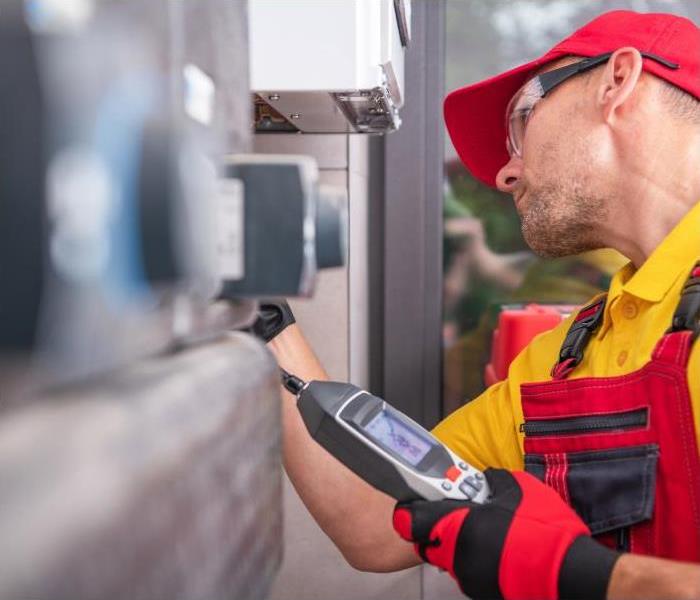 Storm Damage in West Valley City, UT
Storm Damage in West Valley City, UT
Storms can be both unpredictable and devastating. When a severe storm strikes West Valley City, UT, the aftermath can leave homes and properties in disarray. Acting promptly and effectively is crucial to mitigate further damage and begin the restoration process. Here are four essential steps to take after experiencing storm damage in West Valley City to ensure a thorough and efficient recovery.
1. Ensure Safety and Assess the Situation
Prioritize Safety
The first and most important step is ensuring the safety of everyone on the property. After a storm, there may be hazards such as fallen power lines, unstable structures, or gas leaks. Before entering your home or any damaged areas, take these precautions:
Check for Gas Leaks: If you smell gas or suspect a leak, evacuate immediately and contact your utility provider.
Avoid Electrical Hazards: Stay away from any exposed electrical wires and avoid touching anything electrical if you're wet or standing in water.
Assess Structural Integrity: Look for signs of severe structural damage, such as large cracks in walls or sagging roofs. If there is significant damage, it is best to have a professional assess the safety of the building before re-entering.
Document the Damage
Once it is safe to do so, begin documenting the extent of the damage for insurance purposes. Take clear photographs or videos of all affected areas and items. This documentation will be crucial when filing an insurance claim and will help restoration professionals understand the full scope of the damage.
2. Contact Your Insurance Provider
Report the Damage
Reach out to your insurance provider as soon as possible to report the storm damage. Provide them with detailed information about the extent of the damage and share the documentation you collected. Your insurance company will guide you through the claims process and advise you on any immediate steps you need to take.
Understand Your Coverage
Review your insurance policy to understand what is covered under storm damage and any deductibles or limits that may apply. This will help you set realistic expectations for the claims process and determine what costs you might need to cover out of pocket.
Schedule an Inspection
Arrange for an insurance adjuster to inspect the damage. They will assess the situation, verify the extent of the damage, and determine the amount of coverage you are eligible for. Having a clear and accurate report from the adjuster will facilitate the repair and restoration process.
3. Begin the Cleanup Process
Remove Standing Water
If your home has experienced flooding or water damage, it is crucial to remove standing water as quickly as possible to prevent mold growth and further structural damage. Use a wet/dry vacuum or a sump pump to extract water from the affected areas. If the water is extensive or involves contaminated sources, it is advisable to hire a professional water damage restoration service.
Dry Out the Affected Areas
After removing standing water, thoroughly dry out the affected areas. Use fans, dehumidifiers, and open windows to promote airflow and reduce moisture. This step is essential to prevent mold growth and further deterioration of building materials. If you notice any signs of mold growth, such as a musty odor or visible mold, contact a professional mold remediation service.
Remove Damaged Materials
Carefully remove any damaged materials that cannot be salvaged, such as soaked insulation, drywall, or flooring. Be cautious when handling these materials, as they may be contaminated with bacteria or other harmful substances. Proper disposal of these materials is important to ensure a safe and clean environment for restoration.
4. Begin Repairs and Restoration
Hire a Professional Restoration Service
Once the initial cleanup is complete, it is time to begin repairs and restoration. Hiring a professional restoration service, like SERVPRO®, can ensure that the repairs are done correctly and efficiently. Restoration experts will have the necessary equipment and expertise to handle complex repairs and restore your property to its pre-damage condition.
Prioritize Repairs
Start with critical repairs that address structural issues or prevent further damage. This may include repairing roofs, windows, or doors that were damaged during the storm. Addressing these issues promptly will help protect your home from additional weather-related damage and ensure the safety and integrity of the structure.
Work with Your Insurance Company
Coordinate with your insurance company and restoration service to ensure that all necessary repairs are covered by your policy. Keep detailed records of all repair work, including invoices and receipts, to provide to your insurance provider for reimbursement.
Recovering from storm damage in West Valley City, UT, requires prompt action and careful planning. By following these four steps—ensuring safety, contacting your insurance provider, beginning the cleanup process, and starting repairs—you can effectively manage the aftermath of a storm and restore your home to its original condition. Remember, the expertise of professional restoration services, such as SERVPRO®, can make a significant difference in the speed and quality of the restoration process. If you need assistance with storm damage restoration, don’t hesitate to reach out to our team for support and guidance.
SERVPRO's Storm Damage Remediation: A Comprehensive Guide for West Valley City, UT
7/3/2024 (Permalink)
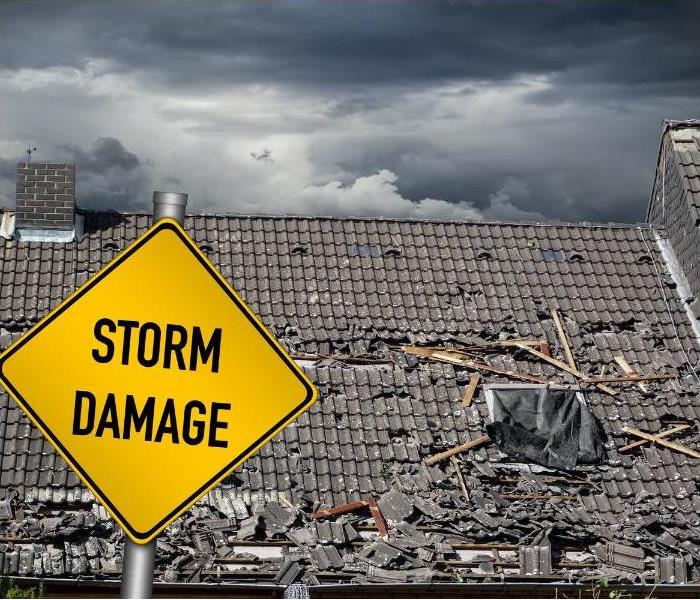 A Comprehensive Guide for West Valley City, UT
A Comprehensive Guide for West Valley City, UT
When a storm hits West Valley City, UT, the damage can be overwhelming. From torrential rains and flooding to powerful winds and hail, the aftermath can leave homes and businesses in disarray. Fortunately, SERVPRO® offers expert storm damage remediation services to help the community recover swiftly and efficiently. Here’s a detailed look at the steps SERVPRO takes to restore properties to their pre-storm condition.
Initial Contact and Assessment
The first step in SERVPRO's storm damage remediation process begins with the initial contact. When a call is received, SERVPRO’s emergency response team is mobilized to respond quickly, understanding that time is of the essence in minimizing further damage.
Upon arrival, the team conducts a thorough assessment of the property. This involves:
Identifying Safety Hazards: Ensuring the site is safe for entry, checking for electrical hazards, structural damage, and potential contaminants.
Damage Documentation: Taking detailed notes and photographs of the affected areas for insurance purposes.
Creating a Restoration Plan: Developing a customized plan of action based on the extent of the damage and the specific needs of the property.
Water Removal and Drying
Storms often bring significant water damage, whether from flooding, rain, or burst pipes. The next critical step is water removal and drying:
Water Extraction: Using industrial-grade pumps and vacuums to remove standing water as quickly as possible.
Drying and Dehumidification: Deploying high-speed air movers and dehumidifiers to thoroughly dry out the affected areas, including walls, floors, and furnishings. This step is crucial to prevent mold growth and further structural damage.
Moisture Monitoring: Continuously monitoring moisture levels using specialized equipment to ensure that all areas are completely dry.
Mold Remediation
In a storm-damaged property, mold can start growing within 24 to 48 hours if moisture isn’t adequately addressed. SERVPRO’s mold remediation process includes:
Containment: Setting up physical barriers and negative air pressure chambers to prevent the spread of mold spores.
Air Filtration: Using HEPA filters and air scrubbers to capture airborne mold spores and improve air quality.
Removing Mold-Infested Materials: Carefully removing and disposing of materials that cannot be salvaged, such as drywall, insulation, and carpeting.
Cleaning and Sanitizing: Cleaning all surfaces and belongings with antimicrobial treatments to eliminate mold and prevent future growth.
Structural Repairs
Once the property is dry and free of mold, SERVPRO begins the process of repairing and restoring the structural integrity of the building:
Board-Up and Roof Tarping: Providing immediate protection from further damage by boarding up windows and placing tarps on damaged roofs.
General Contracting Services: Offering a wide range of repair services, from minor drywall patches to major reconstruction projects, ensuring the property is restored to its original condition or better.
Final Inspections: Conducting thorough inspections to verify that all repairs meet safety and quality standards.
Content Restoration
Storm damage often affects not just the structure but also the contents of a home or business. SERVPRO’s content restoration services are designed to salvage as much as possible:
Pack-Out and Storage: Carefully packing and moving belongings to a secure facility for cleaning and storage during the restoration process.
Cleaning and Deodorizing: Using specialized cleaning techniques and equipment to restore items such as furniture, electronics, documents, and clothing.
Returning Restored Items: Bringing cleaned and restored items back to the property once repairs are complete.
Final Cleanup and Restoration
The final stage in SERVPRO’s storm damage remediation process is a comprehensive cleanup and restoration of the property:
Deep Cleaning: Conducting a thorough cleaning of the entire property, including carpets, upholstery, walls, and ceilings, to remove any remaining dirt, debris, and odors.
Restoration of Aesthetic Elements: Repainting walls, refinishing floors, and performing other cosmetic repairs to ensure the property looks as good as new.
Final Walkthrough: Conducting a final walkthrough with the property owner to ensure complete satisfaction with the restoration work.
SERVPRO’s Commitment to Excellence
SERVPRO of West Valley City, UT, is committed to providing top-notch storm damage remediation services. Their team of highly trained professionals uses advanced equipment and techniques to handle any level of storm damage, ensuring that properties are restored quickly and efficiently.
Key elements of SERVPRO’s approach include:
24/7 Emergency Response: Being available around the clock to respond to storm damage emergencies, minimizing the time between disaster and recovery.
Certified Technicians: Employing IICRC-certified technicians who are trained in the latest restoration techniques and safety protocols.
Advanced Technology: Utilizing state-of-the-art equipment for water extraction, drying, mold remediation, and structural repairs.
Comprehensive Services: Offering a full range of restoration services, from initial assessment and mitigation to complete reconstruction and final cleanup.
Storms can be devastating, but with SERVPRO of West Valley City, UT, property owners have a reliable partner in the recovery process. Their systematic and thorough approach to storm damage remediation ensures that homes and businesses are restored to their pre-storm condition with minimal disruption. From initial contact to final restoration, SERVPRO is dedicated to making it "Like it never even happened."
For those in West Valley City, UT, who have experienced storm damage, contacting SERVPRO immediately can make all the difference in preserving the integrity of their property and returning to normalcy as quickly as possible.
Steps to Preventing and Addressing Frozen Pipes
12/28/2023 (Permalink)
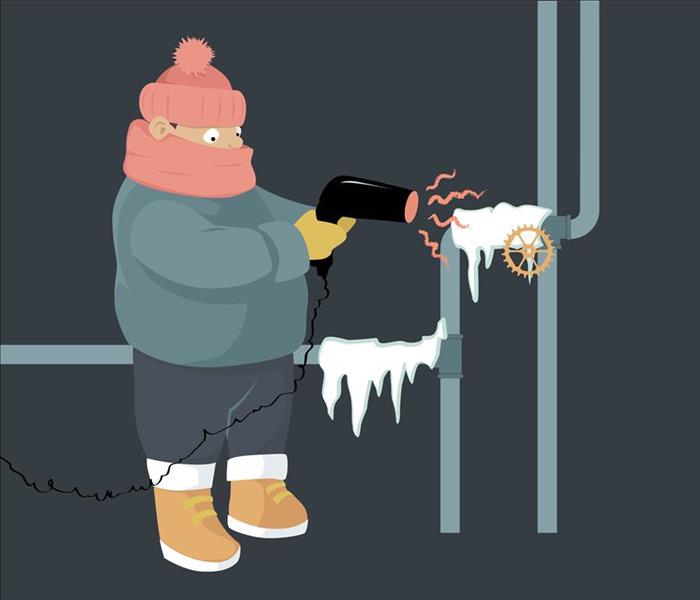 Frozen Pipes in West Valley City, UT.
Frozen Pipes in West Valley City, UT.
As winter blankets West Valley City, UT, with its icy embrace, homeowners must gear up for the challenges that come with the season. One of the most prevalent and potentially damaging issues during winter is frozen pipes. When temperatures plummet, the water inside pipes can freeze, causing them to expand and potentially burst and causing water damage. Dealing with frozen pipes requires a combination of preventative measures and swift action if damage occurs. In this comprehensive guide, we'll delve into the intricacies of frozen pipes, providing practical tips to prevent them and exploring how services like SERVPRO can be a lifeline in mitigating damage.
Understanding the Threat
Frozen pipes pose a significant threat to homes, potentially leading to costly water damage. In West Valley City, where winter temperatures can be unforgiving, taking proactive measures is essential. When water freezes within pipes, it expands, exerting pressure that can cause pipes to crack or burst. The damage often goes unnoticed until temperatures rise, and the ice within the pipes begins to thaw, resulting in leaks and flooding.
Preventative Measures
Insulate, Insulate, Insulate: The foundation of preventing frozen pipes lies in proper insulation. Identify vulnerable areas, such as attics, basements, and crawl spaces, and insulate pipes using sleeves or heat tape. This extra layer helps maintain a consistent temperature, reducing the risk of freezing.
Let the Faucet Drip: Allowing faucets to drip can be a simple yet effective strategy. By letting water flow, you relieve pressure in the pipes, minimizing the chances of freezing. Focus on faucets connected to pipes along exterior walls and those in unheated areas.
Maintain a Consistent Temperature: While it may be tempting to lower the thermostat to save on energy costs, doing so during winter can put your pipes at risk. Keep your home at a stable temperature, especially during the night or when you're away. This ensures that the plumbing stays warm and functional.
Open Cabinet Doors: For pipes located under sinks, opening cabinet doors allows warm air to circulate, providing additional protection against freezing. This is particularly crucial in areas where pipes are exposed to colder temperatures.
Seal Leaks and Gaps: Conduct a thorough inspection of your home for any gaps or cracks that could allow cold air to seep in. Seal these openings with caulk or insulation to prevent drafts, which can contribute to frozen pipes. Not only does this protect your plumbing, but it also enhances overall energy efficiency.
In Case of Emergency: SERVPRO to the Rescue
Despite taking all necessary precautions, frozen pipes can still catch homeowners off guard, leading to potential water damage. In such cases, swift and professional action is paramount. This is where SERVPRO, a trusted leader in the restoration industry, comes into play.
SERVPRO's Approach to Frozen Pipe Emergencies
Immediate Response: SERVPRO understands the urgency of water damage caused by frozen pipes. Their team of experienced technicians responds promptly to mitigate further damage. Time is of the essence, and SERVPRO's quick action can make a significant difference in minimizing the impact on your home.
Water Extraction: Upon arrival, SERVPRO assesses the extent of water damage and employs advanced equipment for efficient water extraction. Removing excess water is crucial to prevent secondary issues such as mold growth and structural damage.
Drying and Dehumidification: After water extraction, SERVPRO focuses on thorough drying and dehumidification. This step is essential in preventing lingering moisture that could lead to mold growth. State-of-the-art drying equipment is used to restore optimal humidity levels in the affected areas.
Restoration Services: SERVPRO's comprehensive restoration services cover everything from damaged drywall and flooring to compromised structural elements. Their goal is to return your home to its pre-damage condition, minimizing disruption and ensuring a seamless recovery process.
As winter's chill settles over West Valley City, UT, homeowners must arm themselves with knowledge and preparation to combat the threat of frozen pipes. By implementing preventative measures and knowing who to turn to in case of an emergency, you can navigate the winter season with confidence, ensuring the safety and integrity of your home. Stay warm, stay prepared, and trust the experts when the unexpected occurs. With SERVPRO by your side, you can weather the winter freeze knowing that a dedicated team is ready to restore your home to its former glory.
3 Things Not To Do After a Flood
8/31/2023 (Permalink)
 Heavy rains may lead to flood damage.
Heavy rains may lead to flood damage.
It’s one of many homeowner’s worst nightmares: a large storm or local disaster has flooded your neighborhood in West Valley City, UT. Many who experience flooding for the first time are unprepared and uninformed, not knowing what to do after flood water has covered the streets or entered their home. To help you prepare, whether you’re facing a flooded home now or foresee its possibility in the future, here are three things not to do after a flood:
3 Things to Avoid After a Flood
1.Remain in your home. For you and your family’s safety, if water has entered your home, it’s important to leave and not reenter until flooding has subsided. In a flood’s immediate aftermath, the risk of rising water is still imminent due to the possibility of more rain, a compromised levy or busted dam. Find refuge outside the flood area, whether it be in a hotel, a loved one's home or a public shelter.
2. Touch the water. Flood water can be contaminated with any number of bacteria, sewage and/or chemicals that can be harmful to your skin and health. It’s also imperative to avoid standing water to minimize the risk of electric shock from electrical lines and equipment touching the water. If you must enter or be around the water for any reason, protective clothing such as rubber boots should be worn.
3. Fix it yourself. Repairing flood damage in a home can require a large amount of construction materials, professional knowledge and skill to ensure the damage is fully repaired and any mold is removed. Instead of trying to take on the job yourself, it’s best to save time and additional headaches by contacting a water damage repair and restoration company.
For any homeowner, flood water is certainly an unwelcome sight. Knowing what to do, or not do, in this type of disaster is imperative to keep you and your family safe and to begin the restoration process successfully.
6 Tips for Preventing Mold Growth After a Flood
8/4/2023 (Permalink)
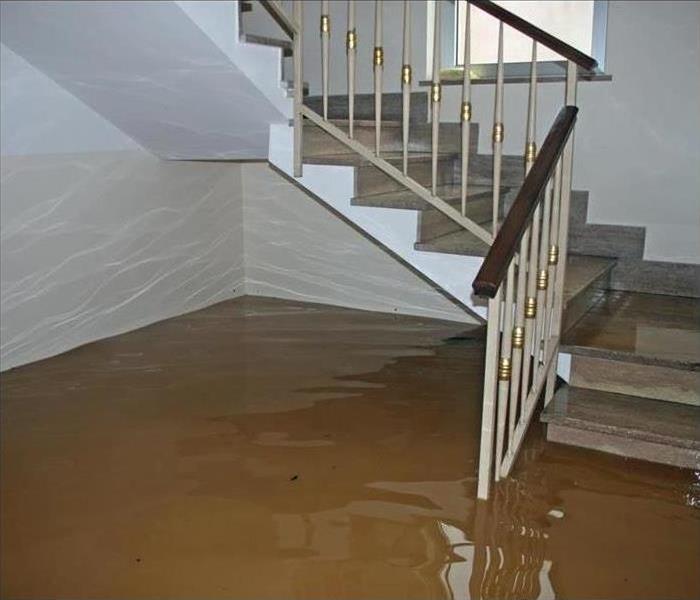 Flooding can cause severe mold damage if not cleaned properly.
Flooding can cause severe mold damage if not cleaned properly.
Floods can cause a significant amount of property damage; however, the initial damage from the water isn't the only problem homeowners face. The moist conditions created by flooding in a home often lead to mold growth. These tips can help you avoid this problem.
6 Ways To Avoid Mold Due To Standing Water
Mold needs several basic things to flourish. Mold requires moisture, food, warmth, and oxygen to grow. It is difficult to eliminate food sources or manipulate the temperature in a home to affect mold. The primary way to prevent mold problems is to reduce moisture.
- Dry Your Property Out Quickly
As soon as it is safe, you should begin drying out your property. Mold can begin growing in 24 to 48 hours from the initial water exposure. This makes it important to remove any standing water and dry out wet materials and contents as soon as you can. You may be able to remove small amounts of water with a wet/dry vacuum. You will probably need professional equipment to remove larger amounts of water. In some cases, it may be wise to contact a water remediation company in West Valley City, UT, to speed up the process of drying out the home.
- Increase Ventilation
If the weather permits it, open windows and doors during the day to increase airflow. Use fans to circulate the air and increase water evaporation. Position the fans to blow air out of doors and windows. Reduce indoor humidity by using dehumidifiers. A dehumidifier designed for home use may work for smaller spaces, but for larger spaces, you may need to rent an industrial model.
- Remove Wet Items
Remove wet debris and contents. Carpets, carpet pads, drywall, ceiling tiles, and other porous materials may need to be discarded because these items are difficult to clean. Salvageable contents may be left outside in the sun to dry or taken off-site by a restoration company for cleaning. Clean surfaces that were exposed to floodwater with a disinfectant or sanitizer to kill mold spores and bacteria. If you can't immediately remove wet carpet, extract the water from it with a commercial carpet extractor or wet/dry vacuum.
- Shut Off Water Sources
If anything in your home is leaking water, shut off the water to your home. As long as there is a source of moisture, mold growth is likely to be a problem. Do not turn the water back on until broken pipes or leaking appliances are repaired.
- Turn Off HVAC Systems
Try to keep your home at a moderate temperature, but avoid over-cooling or overheating. A home that is too hot or too cold can cause the drying process to take longer.
- Watch for Warning Signs
If you are noticing stains on ceilings or walls or noticing musty smells, then you may have a mold issue. Take steps to remove the mold before the problem can get worse.
No homeowner wants to go through the process of restoring a flood-damaged home only to have to deal with a mold growth problem. Fortunately, there are steps you can take to reduce your chances of having to deal with this problem.
4 Things a First Responder Should Know When Working With a Flood
7/19/2022 (Permalink)
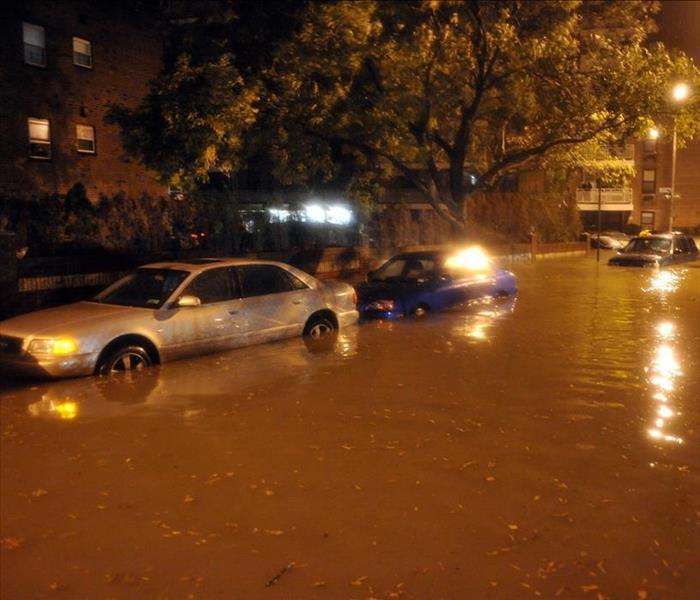 Severe flooding can cause serious damage.
Severe flooding can cause serious damage.
When your home in West Valley City, UT, gets hit with a flood, you need to take action quickly. However, even a first responder cannot run directly into an impacted space. Water and moisture can create an unsafe zone. Appropriate precautions should be taken by anyone entering the premises.
Top Tips for How a First Responder Should Approach a Flood Zone
Floodwater, also known as blackwater, plays host to high levels of pathogens and spores. The onslaught of water takes over an area, drenching it. External bodies of water overflow, or the sewage line backs up. Either way, homes become inhabitants of many organisms and potential hazards. Responders should remain vigilant and aware of the contamination, and understand the toll water takes on buildings. Be sure to follow these four essential tips.
1. Be Sure Your Immunization Records Are Current
The Centers for Disease Control recommends that anyone working with flood response be current in several immunizations. After all, a flooded environment proves challenging, uncertain and cumbersome. Severe flooding weakens structures and displaces items, creating physical obstacles. In addition, dampness encourages rust on metal objects.
These conditions establish a problematic setting where cuts and wounds could quickly and easily occur. Exposure to rusted materials and bacteria complicates injuries further. Therefore, responders should have tetanus and diphtheria shot, called the Tdap for short. In addition, the CDC suggests responders have the Hepatitis B vaccine as well.
2. Use Safety Gear
Minimize injuries and exposure by wearing appropriate safety gear and guarding yourself. Use durable rubber gloves and avoid touching your face and eyes with gloved or bare hands. At the end of the shift, discard gloves appropriately, using a new pair the time you enter. Thoroughly wash your hands with soap and warm water before moving to other activities.
In addition, the skin remains vulnerable, so cover up as much as possible. Have full-body clothes for the worksite, and keep goggles with you at all times. Don't forget a sturdy pair of boots. When you leave, change immediately. Take clothes off before you enter your home, and wash them.
3. Survey Your Surroundings
The United States Occupational Safety and Health Administration emphasizes that floods create multiple hazards for first responders. While water damage proves the most obvious concern, people must also remain aware of other conditions. Responders should consistently keep on their toes, understanding they could encounter the following situations:
- Carbon monoxide buildup
- Extreme heat
- Chemical and biological exposure
- Animal encounters
- Electrical issues
4. Recognize Mold Growth
Note that mold is likely to grow quickly in damp areas, demanding swift cleanup and precautions. Mold spores activate when water and organic matter meet, reproducing within one to two days. Floods establish the perfect conditions.
Use an N-95 mask, and wash everything thoroughly. Furthermore, discard porous, saturated items. Collaborate with an emergency water remediation team to assess the status and use high-quality gear and sanitizing methods.
As a first responder in West Valley City, UT, you face an incredible challenge to help homes and people. Remain cautious, constantly surveying your surroundings and adopting protective measures, to keep yourself and others safe during a flood disaster.
Storm Damage Prevention Tips
7/12/2022 (Permalink)
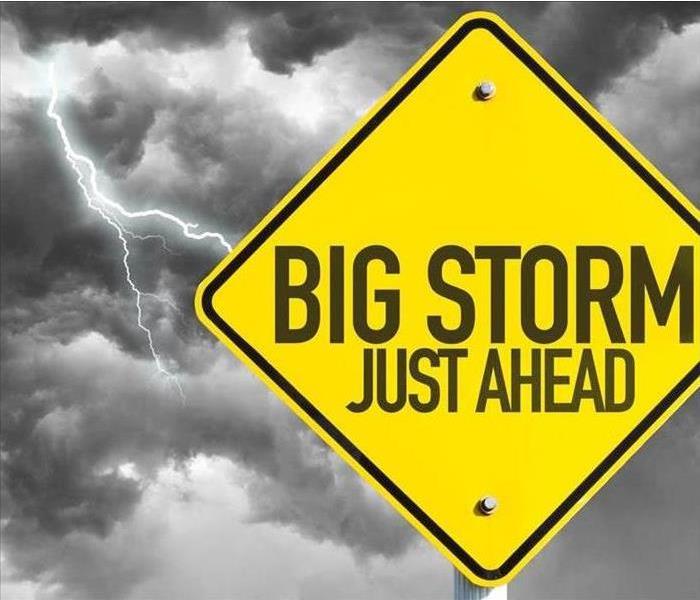 You can prevent a lot of damage to your property with regular inspections.
You can prevent a lot of damage to your property with regular inspections.
Taking care of your commercial property starts with prevention. A severe winter storm in West Valley City, UT, can result in a lot of expensive damage to your commercial building. However, there are several things you can do to prevent or at least minimize the damage the storm causes.
3 Tips For Storm Damage Prevention
- Inspect Building
Regular building inspections are a great way to identify potential problems and take care of them before they get out of hand. At the start of winter, you need a professional inspection of the parts of your building that are particularly vulnerable to storm damage during colder seasons:
- Roof
- Windows
- Foundation
- Plumbing
Look for existing damage as well as ways to fortify the structure. You can prevent a pipe break by making sure your plumbing has adequate insulation. Don't wait until after the storm hits to find out if your building is in good shape.
- Control Water Flow
A winter storm often brings a lot of precipitation with it. If that water has no clear path away from your building to follow, it can pool and freeze on your roof or near the foundation. This can cause cracks that let water seep in as the ice melts, causing interior damage that you may not notice for months. Storm damage restoration specialists recommend regular cleaning of your gutters and downspouts as well as the use of sandbags or other barriers to protect the places that are most vulnerable to leaks.
- Plan Ahead
Some prevention measures require prior notice to use effectively. Have a plan for protecting your building, and make sure everyone knows the part they are expected to play. Pay close attention to the weather reports in your area so that you have plenty of time to get your building ready for an approaching storm.
A winter storm can be dangerous to your building, but there's no reason you can't be ready for it. With regular inspections and a solid emergency plan, you can prevent a lot of damage to your property.
4 Steps of Action To Take After Storm Damage
6/7/2022 (Permalink)
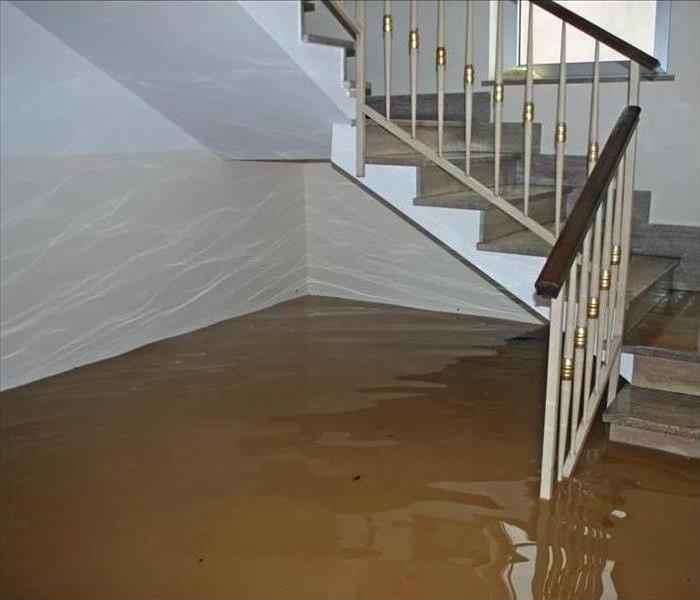 The Specialists suggest you these Steps of Action After Storm Damage.
The Specialists suggest you these Steps of Action After Storm Damage.
Whether you live in an area where the seasons bring an increased risk of hurricanes or an area where a home flood is more likely to occur because of broken pipes, you need to know how to respond after your home has been affected by flooding. Heavy rains, aging pipes, and backed up sewer systems are all potential causes of flooding in West Valley City, UT. Dealing with water or storm damage can be summed up in several vital steps:
Steps to Dealing With Storm Damage
- Begin Drying Out Your Home
This may require shutting off the water to your home. It could also entail using buckets, mops, towels, or wet/dry vacuums to remove water. It's a good idea to open windows (if it's dry outside) and gather fans to circulate the air and prevent moisture from settling on surfaces.
2. Contact Professionals for Advice About Proceeding
There's a lot of potential for errors and further damage when the sheetrock, carpeting, and other elements of the home are covered with water. Call your insurance company for a better understanding of what your policy covers and whether there are specific steps you should take. This is also a good time to call a storm or water damage restoration company. These professionals have resources, training, and tools to appropriately handle cleanup and repairs.
3. Separate Items To Save and Discard
When it's safe, carry wet belongings outside where they can dry. Separate items with too much damage for repairs but don't haul them off yet. It's important that the insurance adjuster can see what you've lost in the home flood.
4. Dry and Disinfect Your Belongings as Quickly and Thoroughly as Possible
It doesn't take long for mold to start growing. If you've stuffed your wet clothes in a plastic bag, for instance, mold may set in within 24 hours. Instead, get your clothes, blankets, and similar materials in for laundering as quickly as you can. Some furnishings, such as mattresses and the pad under your carpet, are prime environments for mold.
It's very important to resist taking steps after a home flood until you've spoken with your insurance provider and restoration professionals. Prompt action is required, so get into contact with the pros as soon as you can.
What You Should Know About Mold Cleanup After a Storm
5/24/2022 (Permalink)
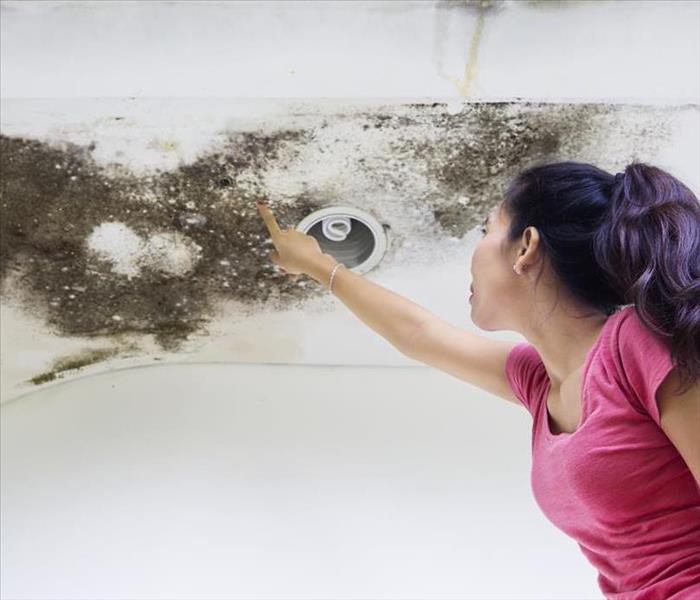 Let Our Professionals help you with the Mold Cleanup After a Storm.
Let Our Professionals help you with the Mold Cleanup After a Storm.
As a homeowner, you owe it to yourself to take care of the property through regular maintenance, home security, and protection against damages due to fire, theft, and even certain types of storms. Insurance policies vary in terms of what perils are covered, especially in certain locations.
After a hurricane or severe thunderstorm, you may experience water damage at your home in West Valley City, UT. Whether as a result of a leak in your roof or floodwater, unaddressed water damage can lead to other serious problems such as mold growth. Here’s what you should know about cleanup.
Important Information to Consider
Mold Removal vs Remediation
You may have heard terms such as cleanup, removal, and remediation used interchangeably, but they have very different meanings when it comes to your home. Removal is simply the act of disposing of objects and surfaces covered in mold. Remediation involves a comprehensive approach that includes the following:
- Assessing the extent of damage
- Removing affected items
- Preventing mold growth
- Employing special cleanup techniques
- Repairing and rebuilding as needed
Cleaning up mold is not a DIY approach. You need to contact a professional mold remediation provider to get the job done.
Difficult Cleanup
The reality is that mold is not something that is easily cleaned with bleach. Mold spores exist everywhere, and even though you may not see mold on a visible surface, it can easily and quickly spread beneath floors, behind walls, and above ceilings. This fungus also can survive in cracks, crevices, and other hard-to-reach places.
Do you have the equipment and energy to cut into your house structure to confirm the source and the extent of the spread? Is it even safe for you to do so? Restoration professionals are fully equipped and experienced in finding out where the mold is to return your home to pre-damage conditions.
Stop the Spread
Mold can spread quickly. Let’s suppose you have flooding in your home that was limited to one area. In the time it takes for you to acquire pumps, wet vacs, and other water removal items, damage can spread to another room unbeknownst to you. Remediation professionals have equipment that can isolate affected areas and spare parts of your home that are unaffected. They know the best way to approach the job to avoid double duty and other mistakes that can extend the cleanup period.
Odor Control
Mold isn’t just unsightly. It also leaves a musty odor that can affect the building structure as well as other possessions. The professionals have the equipment to remove unwanted smells from your house and its belongings. They understand which products are the best for getting the odor out of the air, fabric, upholstery, carpets, rugs, and other items which may not be otherwise damaged. The professionals do what they can to save objects by cleaning and repairing, more affordable alternatives to replacement.
If you have mildew or mold from flooding, burst pipes, or other types of water damage, you’ll need to call the pros right away. You want a complete approach that does more than just removal. The professionals know how to prevent new mold growth and minimize the time and cost associated with a full restoration.
11 Flood Safety Tips
2/22/2022 (Permalink)
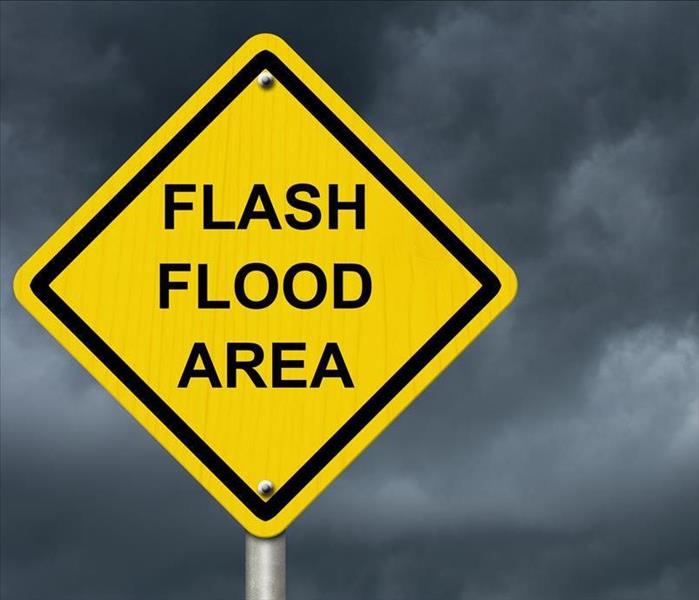 Consider these 11 Flood Safety Tips to be better prepared in case of a Flooding Situation.
Consider these 11 Flood Safety Tips to be better prepared in case of a Flooding Situation.
Flooding can cause serious property damage and create dangerous conditions for property owners and their families. These tips can help you improve your flood safety plan.
11 Flood Safety Tips for Homeowners
You may have limited time to take action when a flood event occurs. For that reason, it is important to have a safety plan in place before a flood happens. These 11 safety tips can help you create your plan:
1. Gather Emergency Supplies
Suggested items include flashlights, batteries, a weather radio, a first aid kit, a sealed plastic bag with necessary medications, pet food and enough non-perishable food and water for three days. Store a minimum of one gallon of water per person and pet for each day.
2. Listen to Weather Updates
Turn on a radio or television and pay attention to weather updates. If flooding seems imminent, prepare to evacuate.
3. Check Immunization Records
If you have a copy of your family's immunization records, store them in a flood proof bag or container. Check the date of everyone's most recent tetanus shot.
4. Secure Outdoor Possessions
Bring lawn furniture, trash cans, grills and other outdoor items inside or secure them to something that isn't likely to float away. You may want to cover securely anchored items that can't be moved with plastic to reduce the amount of damage from water.
5. Turn Off Utilities
If you will need to evacuate as a flood safety measure, switch off all utilities at the main breaker and close the main gas valve.
6. Move To Higher Ground
If you are in a low-lying area, move to higher ground. If you are in a vehicle, avoid driving through floodwater.
7. Avoid Floodwater
Do not return to your home until local authorities have told you it is safe. Do not use floodwater for drinking, bathing, washing dishes, brushing your teeth or preparing food.
8. Dry Out Your Home
Once you have been given the OK to return home, contact a flood remediation company in West Valley City, UT, to dry out your home. Do this as soon as possible. The longer your home remains wet, the more likely you are to have problems, such as rot or mold.
9. Be Aware of Boil Orders
Flood conditions can make tap water unsafe for drinking and bathing. Check the local news for announcements about boil orders. If there is a boil order, only use bottled, treated or boiled water for cooking, drinking or bathing.
10. Avoid Potentially Contaminated Food and Drink
Any food or drinks that may have been in contact with contaminated water should be thrown out. If you aren't sure, throw it out.
11. Avoid Carbon Monoxide Poisoning
If you run a generator or pressure washer, make sure it is a minimum of 20 feet away from windows, doors or vents. Don't run your vehicle inside an attached garage, even if the garage door is open.
Preventing damage to your property is important in a flooding situation, but flood safety is more important. It is better to sacrifice property than to risk your family.
Learn These Storm Tips Before the Clouds Gather
1/24/2022 (Permalink)
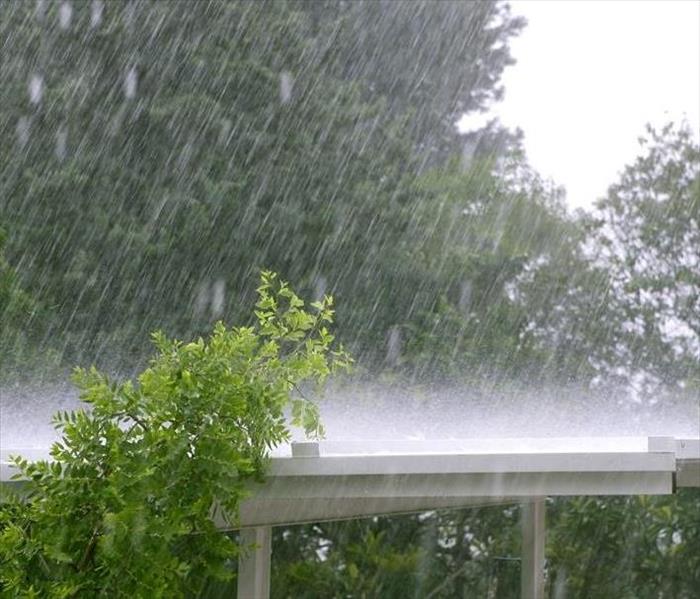 Consider these Storm Tips to reduce damage and stress in your West Valley City, UT house.
Consider these Storm Tips to reduce damage and stress in your West Valley City, UT house.
When you know how to respond after storm damage occurs, you can reduce the long-term consequences of that damage. With more preparation, you'll also increase your confidence during this stressful time, decrease the losses to your home and family, and reduce the amount of money it takes to recover. With the right storm tips, you can avoid many of the complications you'd otherwise face.
Storms Tips To Reduce Damage and Stress
As is generally the case, one of the best ways to avoid storm damage is taking preventative measures:
- Cleaning the gutters and downspouts
- Clearing the yard of debris, overgrowth, and dying branches
- Inspecting the roof and foundation at least once a year
- Putting away or securing yard furnishings and outside toys
After completing these tasks, it's also important to arrange a professional inspection of the roof, the foundation, and the structural integrity of your home. This inspection helps you identify small issues that could become much larger problems because of a storm. The following storm tips guide your actions once the weather clears:
Focus on Safety First
As you begin to assess the damage to your home and property, keep yourself, your family, and your pets safe from hazards such as downed power lines, floodwater, exposed wiring, and broken glass. If there's no power, use a battery-powered flashlight rather than candles or lighters. Be aware of the potential for gas leaks and sewer system problems.
Board Up and Tarp Openings
If you have broken windows or doors or holes in the roof, use plywood and tarps to keep your home secure and to keep out water. Be sure to document the damage and your emergency repairs to share with the insurance company and the adjuster. Any lack of response or permanent repairs could affect the insurance amount you receive for professional cleanup and reconstruction.
Record All Damage
If it's possible to move safely through your property, use a camera to document damage for your insurance claim. It's also important to schedule a professional damage assessment as soon as possible. The insurance company will take this information into consideration as they process your claim. (Before a storm hits, it's important that you understand what type of coverage you have and what you can expect after a storm.)
Contact Necessary Professionals
Your insurance agent is a great source of information and answers to your questions. The agent may also recommend other resources, such as a cleanup and restoration company, federal disaster assistance information, and emergency service providers and management agencies. You only have a 30-day window to file your claim, and there will be many homeowners working with the insurance company because of their own damage.
These storm tips can help you respond after heavy winds and rainfall hit your home. Extreme weather can occur at any time during the year, so make sure you know which actions to take before, during, and after the storm. Mitigation and reconstruction professionals in West Valley City, UT, can provide more information specific to this area. Don't wait for dark clouds before you learn how to protect your home and family.
8 Tips for Tearing Out Flood Damage
8/19/2021 (Permalink)
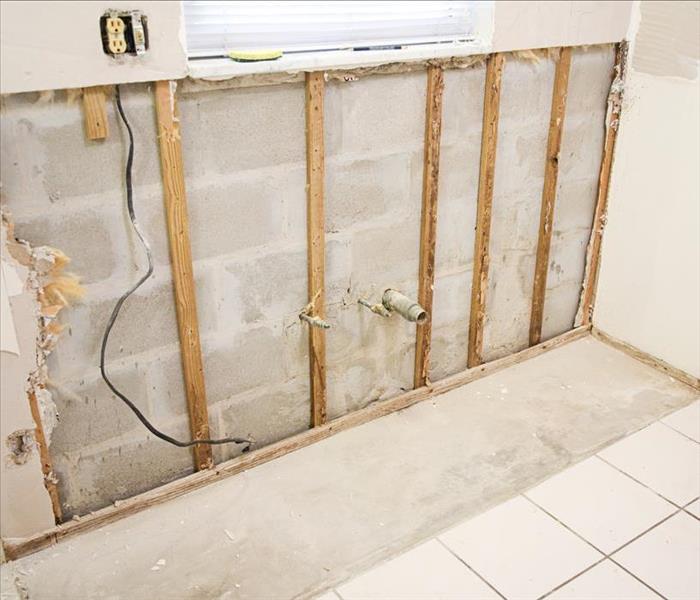 The tear-out process must be done with professional equipment for your safety.
The tear-out process must be done with professional equipment for your safety.
Tearing out damaged items after flooding in your home can be one of the most time and labor-intensive parts of the restoration process.
These tips will help you complete it correctly.
1. Take Precautions
The tear-out process may expose you to mold, dust, mildew, sharp items, nails, broken glass, and other debris. Wear protective gear such as gloves, sturdy shoes, dust masks, and eye protection. It may be a good idea to get a Tetanus shot if you haven't had one in the past ten years.
2. Remove Wet Contents
Before you start tearing out materials, remove wet contents. Leaving items such as wet furniture, clothing, and books in the home can cause the drying process to take longer which increases the risk of mold growth and other complications. Some wet items can be placed outside to dry, though be cautious about leaving furniture and other items that may fade or discolor in the sunlight for too long.
3. Hire a Restoration Company To Remove Black Water
If there is still water in your home from outside flooding or a sewer backup, consider hiring a restoration company in West Valley City, UT, to remove it. Sewage and floodwaters may contain contamination that is unsafe to handle without the proper safety equipment and training.
4. Remove Water Damaged Flooring Other Than Tile
Tiles that have been installed on a concrete slab are usually not damaged by floodwater and can be restored by regrouting and resealing them. Most other types of flooring, including carpets, wood floors, and subfloors will need to be removed and replaced.
5. Remove the Baseboards
Depending on how high the water level was, your baseboards will either need to be removed and replaced or detached and reset. If you aren't sure, consult with a contractor. If you have insurance, you may want to talk to your insurance company about what it will pay for, before you decide what to do.
6. Make a Flood Cut
If your drywall got wet, remove it from the floor to one foot above the waterline. Once you have removed the drywall, remove the insulation up to the same point. Insulation that has gotten wet can not be salvaged. You should remove and replace it.
7. Detach Cabinets
If your cabinets are damaged or the drywall and insulation behind the cabinets are damaged, remove the cabinets. If the cabinets were damaged, they will need to be replaced. If only the walls were damaged, the cabinets can be reset. If the face frame and doors of your damaged cabinets are not damaged, you can remove them and attach them to your replacement cabinets so that they will match the rest of your cabinets.
8. Some Countertops Can Be Salvaged
Laminate countertops can often be detached and reset because they are attached to the base with screws. Tile countertops need to be replaced because they can not be removed in a single piece.
Restoring your home after flooding is a lengthy and work-intensive process. However, taking the time to properly tear out damaged materials before beginning the repair process can help you avoid future problems.
How To Prepare Your Home Before Rain
7/29/2021 (Permalink)
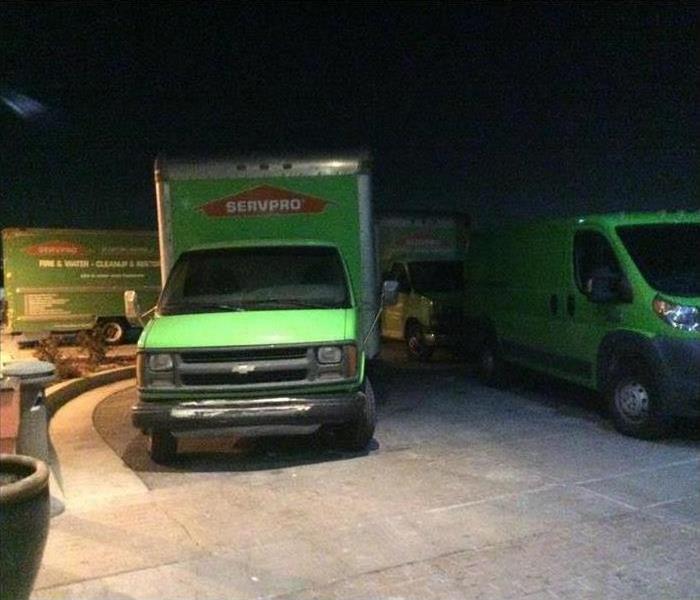 SERVPRO knows that immediate action is crucial when suffering storm damage in West Valley City, UT.
SERVPRO knows that immediate action is crucial when suffering storm damage in West Valley City, UT.
You can't decide when flooding will impact your area; torrential rains can come any time of the year. However, you can affect how much damage the storm can do to your home.
With a little preparation, you can keep storm damage to a minimum.
First, you should prepare your family by doing the following:
• Collecting important items such as extra medication
• Putting important documents in a waterproof casing
• Knowing possible escape routes
• Checking that your insurance covers floods
Once you have done those things, you should protect your home from flood damage. Here are a few ways you can keep your house ready for whatever Mother Nature throws your way:
Clean Your Gutters
If your gutters and storm drains are clogged when the rain starts coming down heavily, this could cause serious problems. Your storm drains give the water a safe place to go, but debris stops this from happening. Instead, the water collects and spills over into areas you wanted to keep it from.
Make sure that you have your gutters and storm drains in West Valley City, UT, professionally cleaned every spring and fall. This simple step can help you avoid severe flood damage. In fact, it could save you money in the long run.
Fill Foundation Faults
Does your foundation have cracks? Even the smallest openings can make flooding worse than it otherwise would be. These breaks allow water to seep in, which causes flood water to damage the foundation. Over time, this can cause further flood damage and even structural problems. Get those cracks fixed while they are still small.
Add Retaining Walls
As you work on landscaping in the spring and fall, consider adding a retaining wall. These beautiful features not only look great, but they can also keep your home from flooding and prevent soil erosion.
No amount of planning is 100 percent foolproof. If floods still enter your home, be sure to have a professional cleanup crew in West Valley City, UT, fix your home immediately.
5 Ways Hurricane Shutters Can Benefit Your Home
7/14/2021 (Permalink)
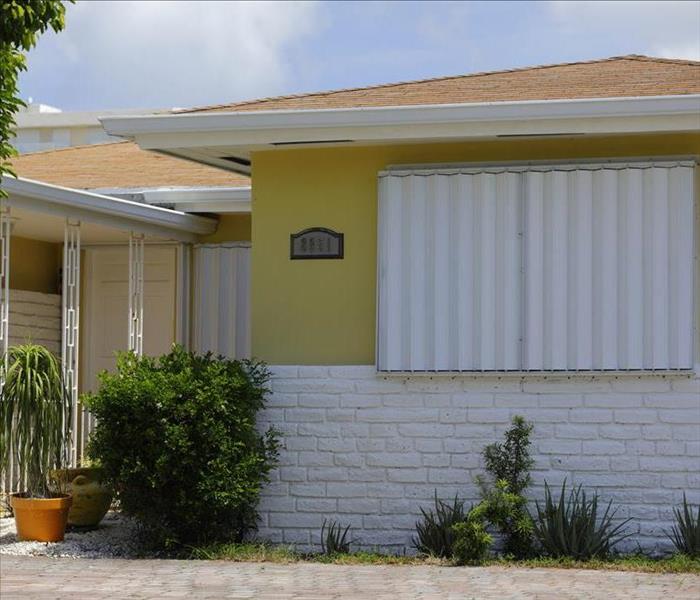 Protecting your West Valley City home from hurricanes is essential to minimize the loss.
Protecting your West Valley City home from hurricanes is essential to minimize the loss.
Between the extremely high winds and heavy rain, a hurricane can be a devastating event for both you and your West Valley City, Utah, property. This is why it's essential to prepare as well as possible to minimize the loss. If you reside or have a vacation property in a hurricane-prone area, it's even more important to have permanent means of protection. Storm shutters are an excellent option for various reasons.
1. More Value for Your Money
Although storm shutters require an initial investment, it's a one-time expense. This is much better financially in the long run because you don't have to buy plywood and supplies to board up your home multiple times a year. This not only saves you money but also time and labor.
2. Insurance Savings
Many insurance companies offer discounts for taking necessary precautions to protect your home against storm damage. Check with your insurance agent to see if fixed shutters qualify you for savings.
3. No Installation Damage
Putting up plywood boards or hurricane panels yourself, particularly when you're in a hurry, can lead to accidentally damaging your home. Fixed shutters are advantageous because they're installed before high winds hit, and they're permanent.
4. Flexibility
Fixed storm shutters are the best option for multi-level properties, balconies, and patios. They can also be customized to your windows and doors for better fit and protection. This customizability allows for a more discreet appearance so they won't look out of place or detract from your home's appeal.
5. Preparation
Having fixed hurricane shutters installed on your home means you're always prepared for severe weather. This preparation is key to offering you peace of mind, especially when you have to be away from home during a severe storm. Another beneficial practice is discovering a storm damage restoration company to call should you sustain a loss.
If you live in an area that regularly sees high winds and severe storms, hurricane shutters could be an ideal solution for your home. Take steps today to protect your property.
Cleaning Requirements After a Flood
5/28/2021 (Permalink)
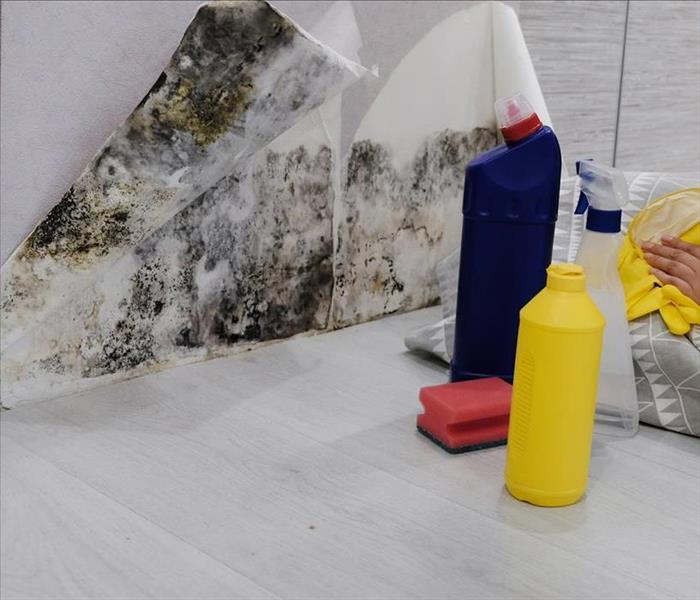 Check cleaning requirements after a flood.
Check cleaning requirements after a flood.
Cleaning up after a flood is a long process. It has to be done right, or you will face problems later on. After a major flood, it is usually better to call a professional cleanup company in West Valley City, UT, to deal with the damage because they know all of the cleaning requirements.
3 Things to Consider When Cleaning After a Flood
Remove Items
The first thing you should do is remove any items that are wet, saturated or starting to mold or mildew. This can include:
- Carpets
- Furniture
- Personal items
- Appliances
You also need to remove all contaminated materials from your home and properly dispose of those that can't be cleaned. When doing a full flood clean, it is better to remove something than keep it and have issues later.
Dry Your Home
It is extremely important to dry your home. You can do this with fans or with drying chemicals. Each part of your home will have different drying and cleaning requirements. If you are unsure of whether something will air dry without an issue, it is better to have it professionally dried just in case.
Drying drywall takes time and patience. In some cases, it is easier just to have your remediation company replace it along with the insulation behind it.
Clean Your Home
Cleaning your home after a flood is not as simple as it seems. Everything needs to be cleaned with an EPA-approved flood disinfectant for surfaces. This disinfectant is more powerful than simple over-the-counter cleaners.
The best thing to do is start at the ceiling and work your way down. Even though parts of your house might escape the flood, evaporating water can contain contaminants that might make you sick later on.
Remember to check each item or materials cleaning requirements. You will find that some items should be removed right away while others can be dried out and cleaned. In any case, your home needs thorough cleaning after any flood.
What if I Don't Have Flood Insurance?
2/24/2021 (Permalink)
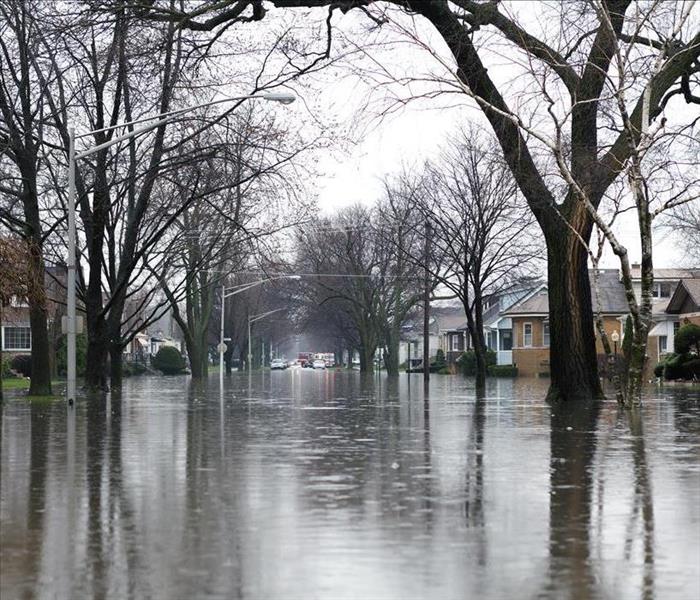 Flooding can lead to severe water damage.
Flooding can lead to severe water damage.
Many areas aren't located on a floodplain or prone to flooding. However, there's always a possibility that you could find your West Valley City, UT, home in a flood one day. In that case, what happens if you don't have flood insurance? There are a few options available to assist you.
3 Things to Consider if You Don't Have Flood Insurance
1. Prepare Ahead of Time
If there's a chance of an impending flood, it's best to be safe by being proactive. Move valuables and important documents to higher levels (e.g., upstairs or up on shelves). You can also put smaller important items in a clean, dry washing machine or dishwasher; they will keep water both in and out. If any of your valuables are too big or bulky to move (e.g., antique furniture), you can put a drain pan under each leg to keep the water away from it. However, this won't help for floodwaters that are more than an inch or two high.
2. Consider a Loan
If you've experienced a flood and your home has sustained damage, but you don't have flood insurance, you can consider getting a loan. The U.S. Small Business Association offers loans for which you can qualify even if you're not a business owner. They're primarily for homeowners who don't have flood insurance. These low-interest loans are available up to $200,000 for primary residence damage. The SBA also offers loans up to $40,000 for personal property damage (also available for renters).
3. Check Into Federal Disaster Assistance
The United States President must declare your state a major disaster area to get federal disaster assistance from the Federal Emergency Management Agency. They also must mark your county for individual assistance. A federal grant from FEMA will offer up to $33,000 per household for expenses incurred from a disaster like a flood. These expenses could include hiring flood damage restoration professionals, temporary housing, belongings replacement, and medical and funeral expenses.
If your home sustains a flood but no flood insurance, there are other options. Understanding them and being prepared before something happens can make a high-stress time a little less stressful.
3 Reasons To Install Storm Shutters
1/26/2021 (Permalink)
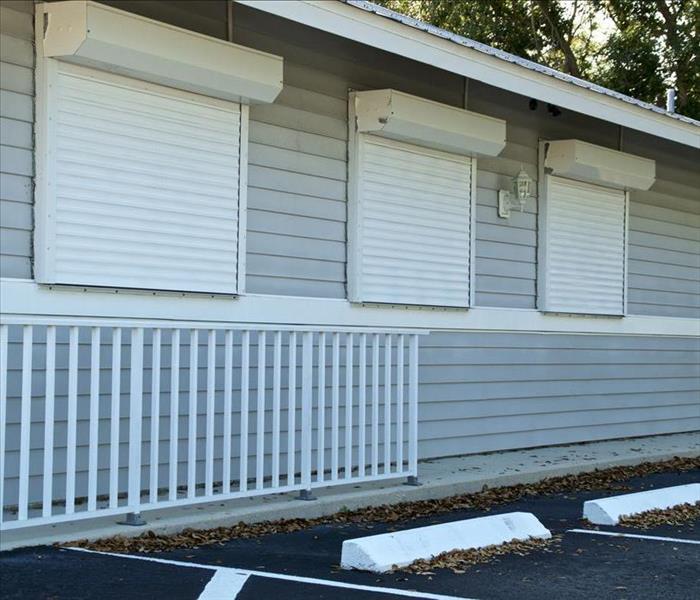 Install storm shutters to protect your home
Install storm shutters to protect your home
While residential properties must adhere to building codes and standards, those requirements ensure that a structure remains standing when subject to typical storm surges and expectations. Unfortunately, high winds are often unpredictable, and while some aspects of a home are built to withstand such gusts, windows are often vulnerable to breakage and penetration. Most storm damage specialists in West Valley City, UT, recommend homeowners install permanent shutters, and they make such a recommendation for three reasons.
3 Reasons Most Storm Damage Specialists Recommend to Install Storm Shutters
1. Always Ready
Having storm shutters installed means you are always ready, even when the weather shifts suddenly. The protective shields are often easy to deploy by either pulling over and latching or unrolling and latching. Whichever option you choose for your home, you ensure quick deployment and minimal damage to your home through a professional installation.
2. Not Intrusive
Many people worry that a shutter will devalue their property because it will affect the curb appeal, but this is not typically the case. A shutter system is looked at as a value add, and while some may be more visible than others, most do not intrude on the overall look of the home, and you will be happy to have them when the high winds start raging in your neighborhood.
3. Cost Efficient
Some people do not see the value in storm shutters, often opting for spontaneous protection through the nailing up of plywood panels. Not only are nails destructive, but the plywood will only need replacement when it comes to the next storm. By installing a storm shutter system, you are saving money because it is a one-time expense.
While building codes and city regulations attempt to cover every natural disaster or issue, high winds can be highly unpredictable, meaning that some structural elements are more susceptible than others to damage. A storm shutter system can protect both your home and family, and it is a one-time cost.






 24/7 Emergency Service
24/7 Emergency Service

















